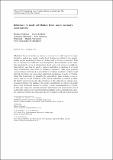Inference of node attributes from social network assortativity
Author(s)
Pentland, Alexander (Sandy)
Download521_2018_3967_ReferencePDF.pdf (1022.Kb)
Open Access Policy
Open Access Policy
Creative Commons Attribution-Noncommercial-Share Alike
Terms of use
Metadata
Show full item recordAbstract
Social networks are known to be assortative with respect to many attributes, such as age, weight, wealth, level of education, ethnicity and gender: Similar people according to these attributes tend to be more connected. This can be explained by influences and homophily. Independently of its origin, this assortativity gives us information about each node given its neighbors. Assortativity can thus be used to improve individual predictions in a broad range of situations, when data are missing or inaccurate. This paper presents a general framework based on probabilistic graphical models to exploit social network structures for improving individual predictions of node attributes. Using this framework, we quantify the assortativity range leading to an accuracy gain in several situations, with various individual prediction profiles. We finally show how specific characteristics of the network can enhance performances further. For instance, the gender assortativity in real-world mobile phone data drastically changes according to some communication attributes. In this case, using the network topology indeed improves local predictions of node labels and moreover enables inferring missing node labels based on a subset of known vertices. In both cases, the performances of the proposed method are statistically significantly superior to the ones achieved by state-of-the-art label propagation and feature extraction schemes in most settings.
Date issued
2019-01-07Department
Massachusetts Institute of Technology. Media LaboratoryJournal
Neural computing & applications
Publisher
Springer London
Citation
Mulders, Dounia et al. “Inference of node attributes from social network assortativity.” Paper in the Neural computing & applications, WSOM 2017, Nancy, France, June 28-30, 2017, Springer London: 18023–18043 © 2019 The Author(s)
Version: Author's final manuscript
ISBN
9781509066391
9781509066384
ISSN
0941-0643
1433-3058